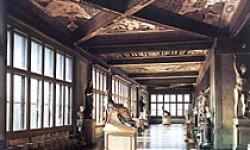The Uffizi Gallery, Firenze,one of the world's finest Museums, traces its origins to 1560 when Cosimo I de' Medici commissioned Giorgio Vasari to plan a large palace with two wings, on the river and almost in the air, to house the Florentine State's administrative and judicial offices (known as "Uffizi").
The true nucleus of the Uffizi Gallery, however, was created by Francis I, Cosimo's son, who, after transforming the top floor of the Uffizi into a place where one could stroll, with paintings, statues and other objects of value, commissioned Buontalenti to create a gallery to hold furnishings and works of art.
The Uffizi Gallery, now house a huge artistic heritage consisting of thousands of paintings from medieval to modern times, a great number of antique sculptures, illuminations, and tapestries.
Over more than four centuries, the history of the Uffizi collections intersected with that of Florentine civilisation.
The original nucleus of the gallery was formed by the first Medici collections, but a vocation for artistic patronage characterised many of the rulers of Florence - none more than the Medici - during the course of the centuries.
Throughout the 19th century, new rooms were opened and the picture gallery continued to expand through the addition of major works including Botticelli's famous The Birth of Venus (acquired in 1815) and Leonardo da Vinci's Annunciation (acquired in 1867).
The acquisition of the Primavera, the splendid panel painted by Botticelli around 1482, dates to 1919.
The 20th century led to the re-arrangement of the works, on various occasions, much restoration and, in recent times, the definitive arrangement of the Contini Bonacossi collection.



Uffizi Gallery reviews
Login to comment